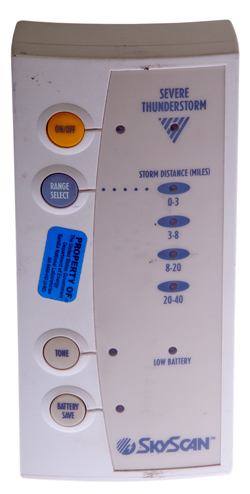SkyScan Severe Thunderstorm Detector
© Brooke Clarke 2014 - 2020 |
 |
This is a handheld weather instrument that detects thunderstorms and how far away they are. It's made by SkyScan (Extreme Research Corp) who has a number of different versions. This one is no longer made, it uses a couple of 9 Volt batteries and the newer model now uses six each AA cells for a lot more battery capacity. This unit has a 5.5 x 2.1 mm DC power jack on the right side marked 9 VDC, the center pin is positive. But when powered through the jace from an HP E3617A lab grade DC power supply the unit beeps often in the 20-40 mile range. But when the sensitivity is turned down to the 3-8 mile range the 20-40 mile LED blinks but the tone does not sound.
When running from the external power jack and not in battery saver mode the unit draws between 13 and 30 ma at 9.0 Volts.
When my HP LaserJet 4050N starts printing the SkyScan goes crazy. It also reacts to switching of electrical loads elsewhere in the house.
It also seems to be more sensitive once something triggers it. That can be fixed by a power cycle.
I left it on last night connected to the HP lab power supply and this morning it was off, so even when Battery Save is NOT selected there seems to be an automatic shutoff function.
This means you can not use it 24/7 as a storm monitor, but only when there's a real chance of severe thunderstorms.
The best way to use this device may be outdoors away from buildings.
The Jameco p/n 1940686 (Mean Well GS06U-2P1J) runs from 100 - 240 VAC @ 47 to 63 Hz and has a 9 Volt output up to 600 ma, but the SkyScan only draws 30 ma so there's plenty of head room.
The unit is microphonic (Wiki), i.e. tapping it or the surface it's standing on will set off the alarm.
Robert Watson-Watt came up with a system based on crossed loop antennas and a very early oscilloscope (WE 224) that would display on the screen lightening strikes so you could get an idea of their bearing (and distance?). See my Radio Direction Finding web page for more.
Battery
After pressing the On/Off button the Skyscan does a self test which causes all the LEDs to light in sequence, see video below.
The On/Off LED will blink when in this mode.
If the Tone button is pressed (it should be) then both the On/Off LED and the Tone will blink on, and when they turn off one of the Range LEDs will blink.
Confirm proper range by watching start-up sequence and use Range Select if needed.
This way you know that Tone has been selected and what range is selected.
Pressing Battery Save causes only the battery save LED to blink (fewer LED means lower current drain).
External Power
Press On button.
Press Tone button. Confirm proper range by watching start-up sequence and use Range Select if needed.
Press Battery Save 2 times. On LED on solid, Tone LED blinking, one of the Range LEDs blinking.
After awhile the range LED stops blinking and the On LED is on and the Tone LED is blinking.
Severe Thunderstorm Warning
11 June 2014 - This morning the Severe Thunderstorm LED was on and the SkyScan was beeping, see photo at top of this page.
It was cloudy and it's been hot (105 F a few days ago and 101 yesterday). Maybe there was lightening nearby?
It seems that once the SkyScan has a warning it keeps on telling you about it, even if the danger has passed.
By pressing the yellow Off button and then pressing it again after a few seconds the warning can be made to go away.
Battery Compartment and
two ferrite core pickup coils
This is the power on sequence.
When taking a still photo using studio strobe lights the unit triggered.
2953020 Meteorological apparatus, James W Hunt Electroanalysis Co, 1960-09-20, -
5263368Hand-held lightning detection and ranging device, James W. Breitmeier, Samuel B. Clubb, Edward F. Shaver, Skyscan Technologies, Inc., Apr 27, 1992, 73/170.24, 324/72, 342/460 - this unit works by using two channels, one at 700 Hz and the other at 1400 Hz.
5541501Lightning and storm warning method and apparatus, Richard I. Kohls, John F. Kohls, Stephen L. McCarter, Edward F. Shaver, Paris H. Wiley, Skyscan Technologies, Inc., Apr 27, 1992, 324/72, 342/460, 702/4, 73/170.24 - This looks very much like this unit.
Calls:
4023408Stormscope, Paul A. Ryan, Nicholas Spitzer, Dytronics Company, Inc., Jan 10, 1975, 73/170.24, 324/72 - Fig 2 Relative amplitude vs. Frequency.
100 Hz to 8000 Hz up slope, 8 to 80 kHz flat, 80 kHz to 2 Mhz down slope.
-------------------------Related ---------------------
5448161 Transformer-coupled photodiode circuit for lightning and other light pulse detection, Leon G. Byerley, III, Alburt E. Pifer, Lightning Protection Technology, 1995-09-05, 324/72; 324/96; 340/601; 356/226; 73/170.24 - used in the Campbell Scientific CS110 Electric Field Meter.
An Instantaneous Direct-reading Radiogoniometer by Robert Watson-Watt, 1926
Campbell Stokes Sunshine Recorder
Dent Meridian Instrument - Dipleidscope
Digital Photography 204: Studio Flash - triggers like lightening
Heathkit ID-4001 Weather Station
Oregon Scientific BAR122HGLA indoor WWVB clock, barometer, temperature, humidity & THGN321ES outdoor temperature and humidity.
IR Cloud Sensor
Radar Warning Receivers use Time Of Arrival (Wiki) to give an instantaneous indication of the bearing of the threat
Seismometer & Geophone
Sensors - extensive page with many sensor types
Soil Moisture Instruments
StormScope - airborne lightening location display
Sundial Sundials
SD_Pat2 Sundial Patents
TMQ-34 Meteorological Measuring Set -
Weather
Techlib (Charles Wenzel) Lightning Detectors (numerous versions) & Simulator
eBay "lightning detectors" - some ready made units below $30
PRC68, Alphanumeric web page index, Products for Sale, Contact
Page created 25 April 2014